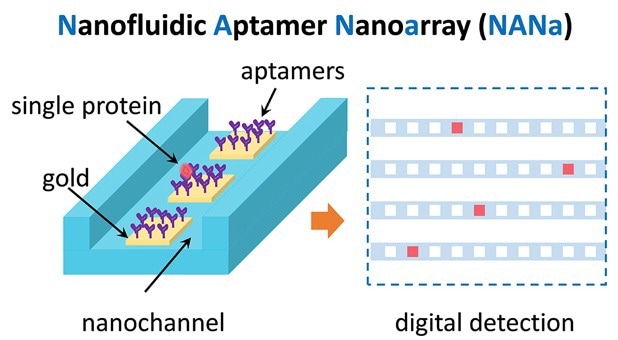Techniques that can quantify biomolecules with the highest degree of precision and specificity are essential to the rapidly developing field of precision medicine.
 Principle of Nanofluidic Aptamer Nanoarray (NANa). Schematic illustration of the NANa principle for stochastically capturing and digitally detecting single proteins. Image Credit: Yan Xu, Osaka Metropolitan University
Principle of Nanofluidic Aptamer Nanoarray (NANa). Schematic illustration of the NANa principle for stochastically capturing and digitally detecting single proteins. Image Credit: Yan Xu, Osaka Metropolitan University
An important step has been taken in this direction led by Associate Professor Yan Xu of the Graduate School of Engineering at Osaka Metropolitan University and his international research team in collaboration with Professor Yong Wang of the Department of Biomedical Engineering at The Pennsylvania State University.
The research team created an innovative nanofluidic technology that can stochastically capture individual proteins and digitally identify them at their naturally high concentrations. The future of customized disease prevention and treatment could be established by this discovery.
Precision medicine strives to customize prevention and treatment plans based on a patient’s unique genetic data, environmental variables, lifestyle choices, and other influences. Accurately measuring biomolecules, including genes and proteins, within individual cells is essential.
However, until now, there have not been any techniques that can handle the small volume of a single cell’s content—typically on the scale of picolitres (10–12 L)—while also characterizing biomolecules in cellular contexts with high concentrations.
The Nanofluidic Aptamer Nanoarray, or NANa for short, is an instrument with a nanochannel-based chip created for the digital assay of individual molecules in a sample with an ultrasmall volume similar to that of a single cell. NANa can stochastically capture and digitally detect individual target protein molecules, even in samples with large concentrations of the synthetic antibodies known as aptamers.
The device’s nanochannels are packed with these aptamers, which bind to specific molecules.
The researchers want to investigate the integration of AI-based image identification technology with biological big data in the future, conduct practical demonstrations with genuine cell samples, and digitize the measurement data that was obtained.
Humans are complex organisms consisting of a vast number of cells. We hope NANa, which digitizes information on the number of biomolecules in individual cells, will serve as a bridge between life science and information science, paving the way for precision medicine in the future.
Yan Xu Associate Professor, Graduate School of Engineering, Osaka Metropolitan University
SPS KAKENHI (Grant Nos. JP19KK0129, JP26706010, JP21H04640, JP20H00497, and JP21J14595), MEXT KAKENHI (Grant Nos. JP26107714, JP21H05231, and JP19H04678), JSPS Invitational Fellowships for Research in Japan (Grant No. S19151), JST PRESTO (Grant No. JPMJPR18H5) and JST CREST (Grant No. JPMJCR18H2) provided funding for the study.
Journal Reference:
Yang, J., et al. (2023) Nanofluidic Aptamer Nanoarray to Enable Stochastic Capture of Single Proteins at Normal Concentrations. Small. doi:10.1002/smll.202301013.